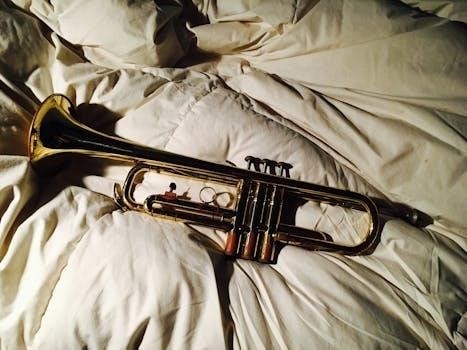This section delves into the world of the “Cherokee” trumpet PDF‚ exploring its rich history and various interpretations. We will examine different arrangements‚ transcriptions‚ and educational resources‚ offering a comprehensive look at this jazz standard.
Overview of the Cherokee Composition
Ray Noble’s “Cherokee‚” a cornerstone of jazz repertoire‚ presents a compelling study for trumpet players. It’s known for its challenging chord progression and brisk tempo‚ demanding technical prowess and improvisation skills. The composition’s structure provides a framework for various melodic interpretations. The song’s harmonic richness allows for extensive exploration of scales and arpeggios. Its enduring popularity ensures a wide array of transcriptions and arrangements. Furthermore‚ the piece has been interpreted by numerous renowned artists. These diverse performances showcase the versatility of this particular musical piece. This has resulted in various educational resources being created for students wanting to learn the piece. The piece is an important part of a jazz musician’s journey.

Trumpet Solos and Transcriptions
This section highlights notable trumpet solos on “Cherokee‚” including transcriptions from Clifford Brown‚ Charlie Parker‚ and others. We explore their unique approaches and improvisational techniques.
Clifford Brown’s Trumpet Solo Transcription
This subsection focuses on the iconic trumpet solo by Clifford Brown on “Cherokee.” His rendition‚ often cited as a masterpiece‚ is available in transcribed form for study and performance. The transcription captures his fluid lines‚ harmonic sophistication‚ and rhythmic drive‚ providing valuable insights for aspiring jazz trumpeters. The analysis of his solo reveals a deep understanding of the chord changes and his ability to create melodic phrases that are both memorable and inventive. Various resources offer his solo in PDF format‚ allowing musicians to learn and interpret his approach. The tempo is around 350 bpm‚ which is very fast. The solo has two swing choruses.
Charlie Parker’s Solo Transcription for Bb Instruments
This section highlights Charlie Parker’s alto saxophone solo on “Cherokee‚” specifically transcribed for Bb instruments‚ making it accessible for trumpet players. Parker’s solo‚ known for its bebop vocabulary and virtuosic phrasing‚ provides a different perspective on the tune. The transcription allows trumpet players to explore Parker’s melodic ideas and rhythmic concepts. It includes the chord changes and is great for learning improvisation. This transcription is a valuable resource for musicians wishing to understand the bebop style. The solo is arranged for Bb instruments. It is great to study this transcription for learning about jazz.
Wynton Marsalis’s Trumpet Solo Analysis
This section explores Wynton Marsalis’s trumpet solo on “Cherokee‚” providing an analysis of his performance. Marsalis’s solo‚ known for its technical brilliance and melodic invention‚ is a benchmark for contemporary jazz trumpet playing. The analysis will focus on his phrasing‚ use of scales and arpeggios‚ and overall approach to improvisation. The solo is comprised of two swing choruses and is performed at a tempo of 332 bpm. We will examine his articulation‚ rhythmic variations‚ and how he interacts with the underlying chord changes. This analysis provides valuable insight for trumpet players.
Tom Harrell’s Solo on Cherokee
This section focuses on Tom Harrell’s solo on “Cherokee‚” a notable performance that has been transcribed and studied. Harrell’s distinctive style‚ characterized by its lyrical approach and sophisticated harmonic choices‚ is explored in detail. His solo‚ available in PDF format‚ is a valuable resource for aspiring improvisers. The analysis will highlight his melodic development‚ use of space‚ and unique rhythmic ideas. We will examine how Harrell navigates the complex chord changes of “Cherokee‚” and how he creates a narrative within his improvisation. This exploration provides a look into the artistry of a jazz master.

Sheet Music Availability
This section explores the availability of “Cherokee” sheet music‚ including free resources‚ versions for different instruments‚ and arrangements for various ensembles. We provide options for all musicians.
Free Sheet Music Resources
Numerous online platforms offer free sheet music for “Cherokee‚” catering to various instruments and skill levels. These resources include transcriptions of famous solos‚ such as Clifford Brown’s‚ and arrangements for different ensembles. Sites like Sheet Music Direct and other online communities provide access to downloadable PDF and MIDI files. Musicians can find arrangements for piano‚ guitar‚ flute‚ and more‚ allowing for practice and learning without cost. Always verify the accuracy and copyright of free music. Utilizing these resources can be a great way to explore this classic piece.
Sheet Music for Various Instruments
The versatility of “Cherokee” is reflected in its availability for various instruments beyond the trumpet. Sheet music can be found for piano‚ guitar‚ flute‚ and other common instruments‚ allowing musicians of different specializations to enjoy the piece. These arrangements often include the melody‚ chord changes‚ and sometimes transcribed solos. The accessibility of versions for varied instruments allows for diverse interpretations and ensemble performances‚ making “Cherokee” a popular choice for study and performance. This wide range ensures that almost any musician can explore this classic tune.
Arrangements for Different Ensembles
Beyond individual instrumental versions‚ “Cherokee” also boasts arrangements tailored for diverse ensembles. These include settings for jazz bands‚ brass quartets‚ and mixed quartets‚ among others. Such arrangements showcase the song’s adaptability‚ allowing for performances in various settings‚ from small combos to larger ensembles. The different voicings and harmonies provided in these ensemble versions offer a rich musical experience. They allow each instrument to contribute uniquely to the overall texture‚ transforming a familiar melody into a new and captivating sound. Many arrangements also feature specific solo sections‚ highlighting the talent of each musician.
Specific Arrangements and Performers
This section highlights notable arrangements and performances of “Cherokee‚” focusing on specific artists and their unique interpretations. We will explore the contributions of arrangers such as Alan Baylock and performers like Chet Baker.
Alan Baylock’s Arrangement of Cherokee Trumpet Soli
Alan Baylock’s arrangement of “Cherokee” trumpet soli is a significant contribution to the repertoire‚ showcasing his innovative approach to jazz composition. This arrangement has gained popularity among musicians for its challenging yet rewarding nature. It’s often performed by advanced ensembles seeking to explore intricate harmonies and rhythmic complexities. The arrangement is available for download and print‚ catering to musicians at various levels. Baylock’s take on the classic tune offers a fresh perspective while retaining the essence of Ray Noble’s original composition. It is frequently used in educational settings‚ helping students to develop their technical skills and musicality. This rendition is a testament to Baylock’s prowess as an arranger and his ability to transform a familiar melody into a vibrant musical experience.
Chet Baker’s Trumpet Solo Sheet Music
Chet Baker’s rendition of “Cherokee” is highly sought after by trumpet players for its lyrical phrasing and laid-back approach. Sheet music for his solos on this tune is readily available‚ allowing musicians to study his improvisational techniques. These transcriptions provide invaluable insights into Baker’s unique style‚ focusing on melody and a relaxed swing feel. His versions often emphasize the harmonic structure of the piece‚ making them excellent for analysis. The sheet music typically includes chords and instrumental parts‚ aiding in both solo practice and ensemble performance. Baker’s interpretation remains a favorite among jazz enthusiasts‚ with his recordings and transcriptions continuing to inspire generations of musicians.
Ray Noble’s Original Composition
Ray Noble’s original composition of “Cherokee” serves as the foundation for countless jazz interpretations and trumpet solos. This section focuses on the history and structure of Noble’s piece‚ offering an understanding of its harmonic framework and melodic themes. The original score is typically found in various arrangements‚ demonstrating its versatility across different instrumentations. It is important to understand the original form before diving into modern transcriptions. Understanding Noble’s intent can provide context for subsequent improvisations and arrangements by musicians. Examining the original composition is a cornerstone for any serious student of this jazz standard‚ allowing for a deeper appreciation of the evolution of the song and its legacy.

Educational Resources
This section offers valuable learning tools such as chord changes and improvisation techniques. Resources include transcriptions and analysis to enhance understanding and skill development for trumpet players studying “Cherokee.”
Chord Changes and Improvisation
Understanding the chord changes in “Cherokee” is crucial for effective improvisation. This section will provide insights into the harmonic structure of the tune‚ focusing on the ii-V-I progressions and other common jazz harmonic devices. We will explore various approaches to improvising over these changes‚ drawing inspiration from the solos of masters like Charlie Parker and Clifford Brown. The resources will also include exercises to help students develop their melodic and rhythmic ideas‚ allowing them to create their unique improvisational language. Additionally‚ we will look at how to use scales and arpeggios to construct compelling solos over the “Cherokee” chord progression. Learning to navigate these changes effectively is essential for any aspiring jazz musician.
University of North Texas One O’Clock Lab Band Transcription
This section highlights a specific transcription of “Cherokee” performed by the renowned University of North Texas One O’Clock Lab Band. This transcription offers a valuable learning resource for aspiring musicians‚ showcasing the band’s interpretation of Ray Noble’s classic composition. The arrangement provides insights into ensemble playing‚ orchestration‚ and soloistic approaches within a big band context. We will analyze the trumpet parts specifically‚ examining the phrasing‚ articulation‚ and melodic ideas presented in the transcription. Furthermore‚ we will discuss how the One O’Clock Lab Band’s rendition contributes to the rich history of “Cherokee” interpretations and provides inspiration for musicians studying jazz and big band music. The transcription serves as a model for performance.

Additional Notes
This section will explore tempo and key variations in different “Cherokee” trumpet performances. We will also analyze musical notation‚ providing insights into how to interpret the written music effectively.
Tempo and Key Variations
The tempo of “Cherokee” can vary significantly across different performances and transcriptions. Clifford Brown’s version‚ for instance‚ is performed at a brisk 350 bpm‚ while others might opt for a slower‚ more relaxed pace. Key variations also exist‚ with many transcriptions available in C major and Bb‚ adapting to various instruments and player preferences. These diverse interpretations highlight the flexibility of the piece‚ making it a favorite for musicians to explore different tempos and keys. Understanding these variations is crucial for both performance and analysis.
Analysis of Musical Notation
Analyzing the musical notation of “Cherokee” reveals intricate details about its structure and harmonic content. Transcriptions‚ often presented in treble clef‚ showcase the melodic lines and chord changes. The notation includes symbols representing notes across three octaves‚ providing a detailed view of the composition. Examining the rhythmic patterns‚ phrasing‚ and articulation within these notations is essential for accurate interpretation and performance. Understanding these notational elements allows musicians to grasp the composer’s intent and personalize their rendition.

Leave a Reply
You must be logged in to post a comment.